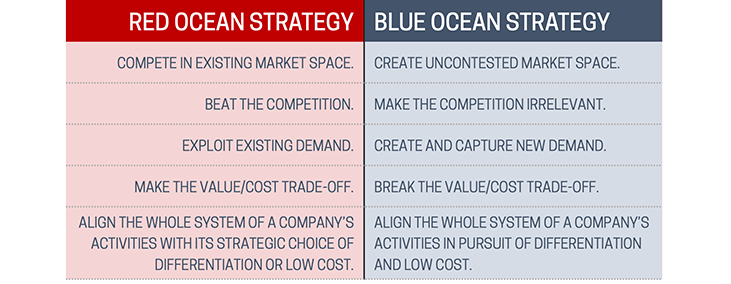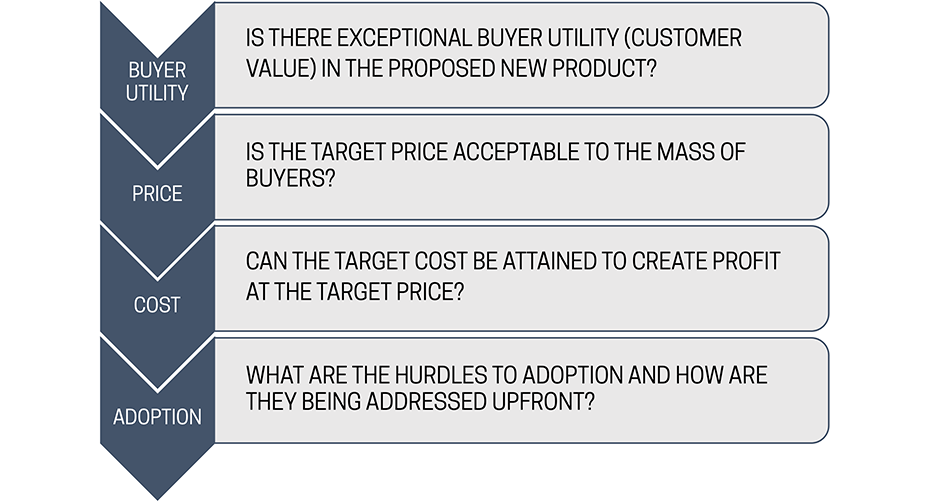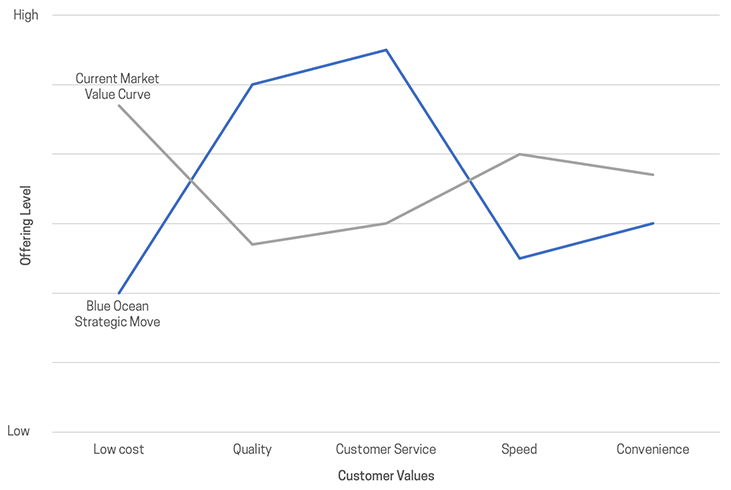Blue Ocean Strategy
Blue Ocean Strategy encourages innovation by focusing on product development within new markets, rather than within the limits of existing market boundaries.

What it is
In their 2004 Harvard Business Review article, INSEAD professors W. Chan Kim and Renée Mauborgne described two distinct spaces within the business environment: red oceans and blue oceans.
Red oceans represent the market boundaries of existing businesses, whereas blue oceans represent the unknown market space. In red oceans, boundaries are set, and the market is well understood and contested. In blue oceans, however, no such competition exists, as the market is not yet in existence. Rather than fighting for a slice of the existing market, demand within blue oceans is created by new products, often giving rise to meaningful opportunities for fast-paced growth.
The following table identifies some of the key differences between red ocean and blue ocean strategies:

Instead of launching new products into existing markets, thereby engaging in a head-to-head battle with competitors, Kim and Mauborgne advocate searching for blue ocean opportunities outside of the conventional market boundaries where no competition exists.
Within these blue oceans, opportunities exist for real value innovation where a company can positively affect its cost structure and provide value to customers simultaneously. Value to customers is provided through innovative products and services which have never previously existed. Cost savings are made by eliminating and reducing costs resulting from traditional, red ocean competition. Once customers recognise the superior value of the new products and services and the new market becomes more widely recognised, costs will fall further due to economies of scale brought about by the higher sales volume.
The blue ocean strategy model provides tools to help managers identify and develop these unoccupied market positions.
Background
While academics had long recognised that those companies that are prepared to adopt innovative business models could be highly successful, most companies operated within traditional models within red oceans. This thinking is characterised by the work of Michael Porter (see Further reading), which recommended that companies choose to pursue either differentiation or a low-cost model to be successful within an existing market.
The internet boom of the late 1990s and early 2000s provided opportunities to pursue innovative and disruptive business models, often with a reach far beyond previously possible and with a relatively low barrier to entry. Companies such as Google, Amazon and Apple quickly rose to become some of the world's largest companies, operating in markets which they themselves defined.
Much academic research was conducted into the process of business model innovation during this period, with a view to providing guidance to companies who may wish to take advantage of this new business landscape or defend themselves against market disruption. Blue Ocean Strategy was one of the most influential publications to result from this research.
When to use it
- To identify opportunities to develop products that can be both different and low-cost.
- To understand what is distinctive about a company's current offerings.
- To find further points of differentiation for a company's current offerings.
- When competition in a current market is too fierce.
How to use it
As mentioned earlier, blue ocean strategy is a set of tools designed to help companies identify and develop products and services within blue ocean opportunities. These tools are based on the formulation and execution principles of blue ocean strategy:
Formulation Principles
- Reconstruct market boundaries - look across alternative industries and strategic groups within them, chains of buyers, complementary product and service offerings, functional or emotional appeal to buyers and time.
- Focus on the big picture, not the numbers.
- Reach beyond existing demand.
- Get the strategic sequence right:

Execution Principles
- Overcome key organisational hurdles:
- Cognitive hurdle - convincing employees of the need for a cognitive shift
- Resource hurdle - gathering the resources necessary to execute
- Motivational hurdle - motivating key staff and stakeholders
- Political hurdle - removing political opposition to change - Build execution into strategy
The Strategy Canvas
To start, Kim and Mauborgne recommend that companies understand customers' underlying wants and needs and compare their offerings with their competitors'. These wants and needs can be visualised by plotting the customer values on a Strategy Canvas, as seen below:

The Strategy Canvas allows strategists to clearly see the factors on which an industry currently competes and invests, what customers receive, and the strategic profiles of the current players in the market. This helps to focus product design on alternatives rather than competitors and on targeting non-customers rather than existing customers.
The Four Actions Framework
Once the current market value curve has been plotted, the Four Actions Framework can be used to create a blue ocean strategic move. The framework poses four key questions, designed to help companies take advantage of "value innovation" by breaking the trade-off between differentiation and low-cost:
- Which factors have the industry long competed on that should be eliminated?
- Which factors should be elevated well above the current standard in the market?
- Which factors should be lowered well below the current standard in the market?
- What factors should be created that have never been offered in the market?
With these four questions answered, a product or service can be designed to take advantage of the blue ocean identified.
Frequently asked questions (FAQs)
Who should be involved in the creation of a blue ocean strategy?
People who have worked within a particular company, market or industry for a significant period can find it very difficult to break out of the current red ocean thinking. Therefore, it can be helpful to assemble a diverse team, some of whom are without the baggage of previous experience.
Does blue ocean thinking eliminate the need for market research?
While the blue ocean strategy has proved to be very effective, in reality, the number of profitable blue ocean opportunities is relatively small. Extensive market research must be carried out once a new offering has been identified to ensure that it meets the needs of the target customer segment and that the market is of sufficient size to warrant investment.
Further reading
Kim, W. C. and Mauborgne, R. A. (2015) Blue Ocean Strategy: How to Create Uncontested Market Space and Make the Competition Irrelevant. Boston, MA: Harvard Business Review Press.
Porter, M. E. (1985) Competitive Advantage: Creating and Sustaining Superior Performance. New York: Free Press.
Some of the links to products provided in this article are affiliate links. This means that the supplier may pay the owner of this website a small amount of money for purchases made via the link. This will have absolutely no impact on the amount you pay.

